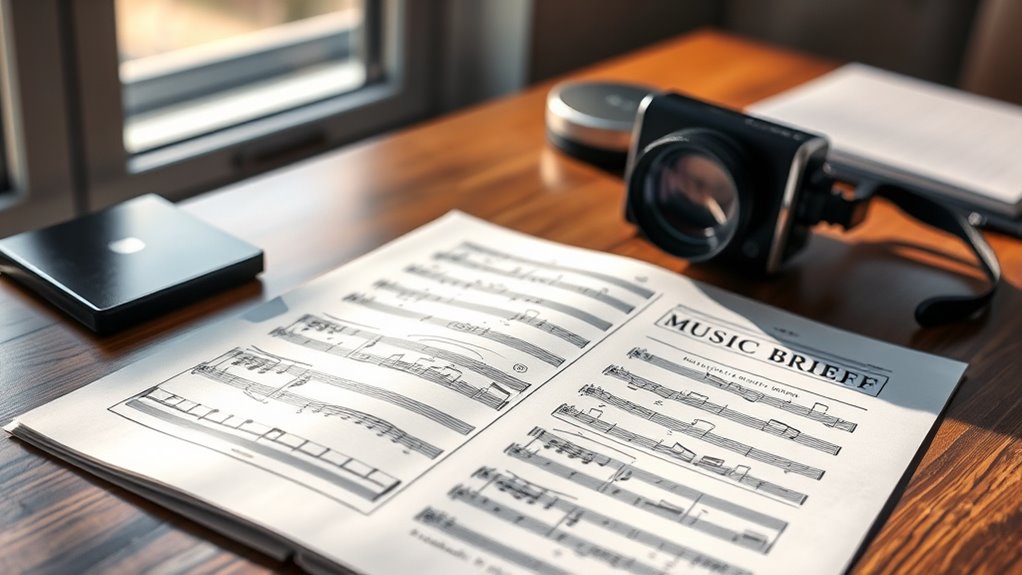To understand a music brief, focus on identifying the project’s mood, genre, and emotional tone, ensuring they match the client’s vision. Pay close attention to licensing restrictions and technical details like track length and format. Clarify if vocals are needed or if royalty-free music is preferred. By carefully analyzing these elements, you align your choices with project goals and legal requirements. Keep exploring, and you’ll discover how to translate these details into successful music production.
Key Takeaways
- Carefully review the project’s mood, emotion, and tone to understand the desired emotional impact.
- Identify the target audience and intended purpose to ensure the music aligns with project goals.
- Check the specified genre and style to guide music selection or creation appropriately.
- Confirm licensing requirements, such as royalty-free or licensed tracks, to ensure legal compliance.
- Note technical details like track length, format, and vocal/instrumental preferences for final delivery.

Have you ever wondered what exactly a music brief is and how to make sense of it? A music brief is fundamentally a roadmap that guides you through what your client or project needs regarding music. It outlines key details like the mood, purpose, target audience, and specific requirements, helping you create or select the right tracks. When you first look at a music brief, one of the most important things you’ll notice is the emphasis on the music genre. This isn’t just about style; it’s about aligning your work with the client’s vision and ensuring it resonates with the intended audience. For example, a commercial for a luxury brand might call for sleek, sophisticated music, while a children’s educational video might need something playful and upbeat. Understanding the specified music genre helps you narrow down your options quickly and avoid wasting time on tracks that don’t fit.
Understanding music genre in briefs helps tailor your choices to match client vision and audience.
Another critical aspect of reading a music brief involves licensing considerations. It’s vital to verify whether the project requires original compositions, licensed tracks, or royalty-free music. Licensing considerations determine what rights you need to secure and what restrictions might apply. For instance, if the brief specifies using copyrighted music, you’ll need to ensure you have the proper licenses to avoid legal issues later on. Conversely, if the project encourages the use of royalty-free music, you should focus on tracks that are cleared for commercial use without additional licensing fees. Paying attention to licensing considerations upfront can save you from costly complications down the line and ensure you’re working within legal boundaries.
As you go through the brief, take note of any specific instructions about the tone or emotion that the music should evoke. Whether the client wants something energetic, calming, or nostalgic, these details influence your choice of genre and arrangement. Also, look for any technical specifications, such as required track length, format, or whether the music should be instrumental or include vocals. All of these details contribute to your understanding of what’s needed and prevent miscommunication. Additionally, understanding the importance of high audio quality can help ensure your final product meets professional standards and client expectations.
In essence, reading a music brief involves more than just skimming through a few lines. It requires you to interpret the details about music genre and licensing considerations carefully, aligning your creative process with the project’s goals. When you pay close attention to these elements, you set yourself up for success, creating music that fits perfectly, complies with legal requirements, and ultimately satisfies your client’s expectations.
Frequently Asked Questions
What Are Common Abbreviations Found in a Music Brief?
In a music brief, you’ll often see abbreviations like “p” for piano, meaning soft, and “f” for forte, meaning loud. You might also encounter notation symbols like “*” for repeat signs, or “cresc.” for crescendo, indicating gradually increasing volume. Understanding these common abbreviations and musical terminology helps you quickly interpret the instructions, ensuring you follow the composer’s intent accurately and perform the piece with the correct dynamics and nuances.
How Do I Interpret Dynamic Markings in the Score?
Imagine the score as a landscape, where dynamic markings are the hills and valleys shaping your musical journey. You interpret these markings as signals for musical phrasing and expressive techniques, guiding you to play softly or loudly. Pay attention to crescendos and decrescendos—they carve out emotional contours—while accents highlight moments of intensity. Embrace these cues to bring the piece to life, adding depth and nuance to your performance.
What Should I Look for Regarding Tempo Indications?
When you look at tempo indications, check for tempo markings like Allegro or Andante to understand the overall feel. Also, pay attention to metronome marks, which give specific beats per minute (BPM). These details guide you in interpreting the tempo precisely, helping you match the composer’s intended pace. Combining both tempo markings and metronome marks ensures you maintain the right speed throughout the piece.
How Can I Identify Key Signatures Quickly?
You can identify key signatures quickly by scanning the beginning of the staff for sharps or flats, which indicate the key. Use your knowledge of musical phrasing and harmony analysis to confirm if the notes align with the expected scale. Recognize common key signatures, and look for accidentals that might suggest modulation. This helps you understand the overall tonality, guiding your interpretation of the music’s phrasing and harmonic structure.
What Are Typical Symbols Used for Articulation?
Did you know that over 80% of sheet music features articulation marks? You’ll see symbols like staccato dots, which tell you to play notes sharply and detached, or accent marks that indicate emphasis. Other common symbols include legato slurs for smooth phrasing and tenuto lines for sustained notes. Recognizing these articulation marks helps you interpret musical phrasing accurately, making your performance more expressive and true to the composer’s intent.
Conclusion
Think of a music brief as your map through a musical jungle. By understanding its symbols and notes, you’re guiding yourself safely to the treasure of a successful project. Keep your eyes sharp and your mind open, and you’ll navigate with confidence. Remember, mastering this map transforms confusion into clarity, turning a formidable landscape into a well-charted adventure. With practice, you’ll find yourself confidently reading music briefs like a seasoned explorer.










